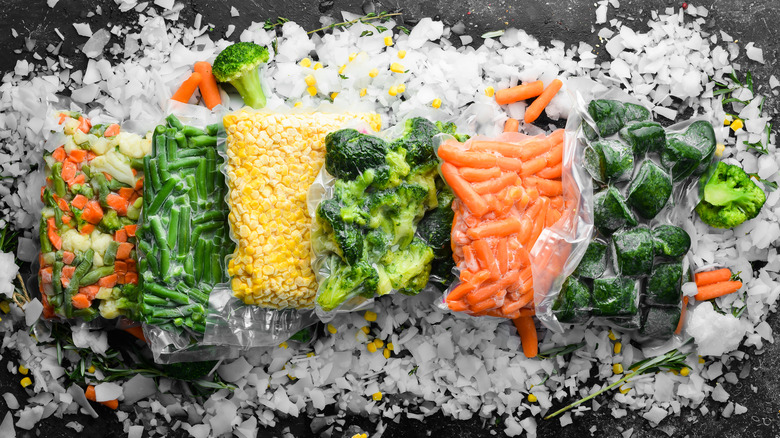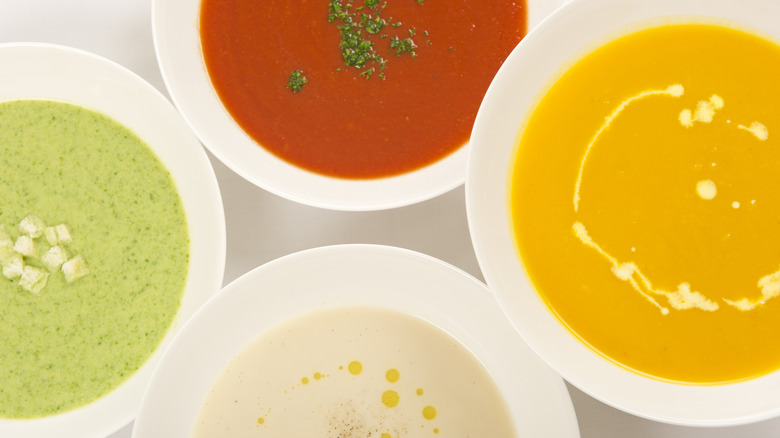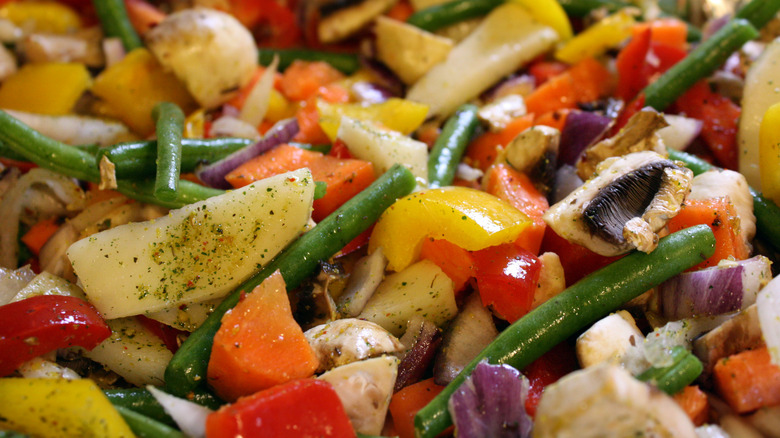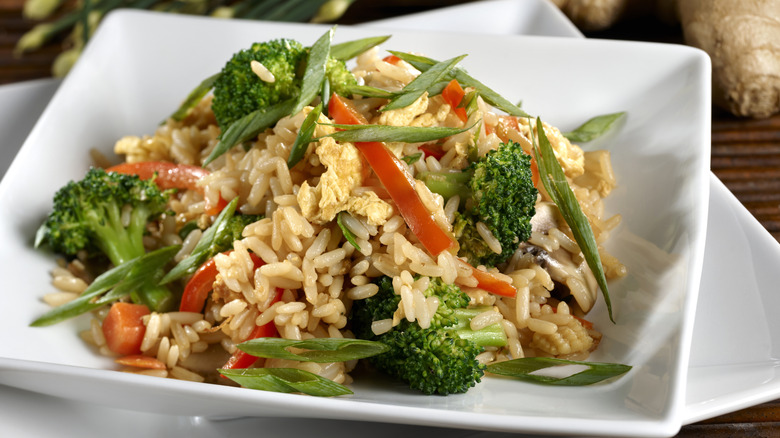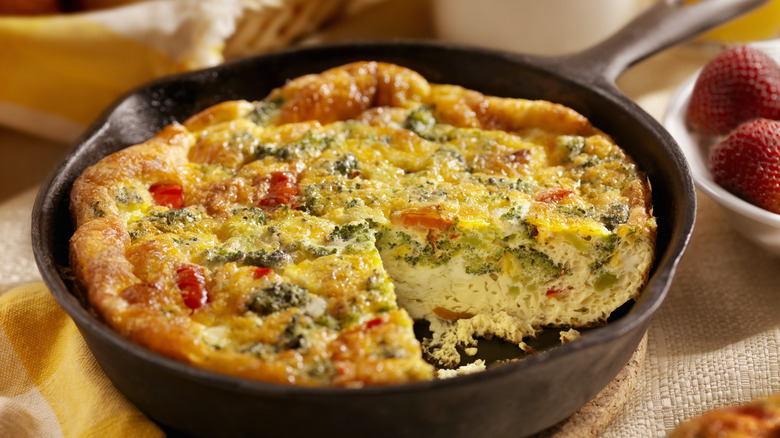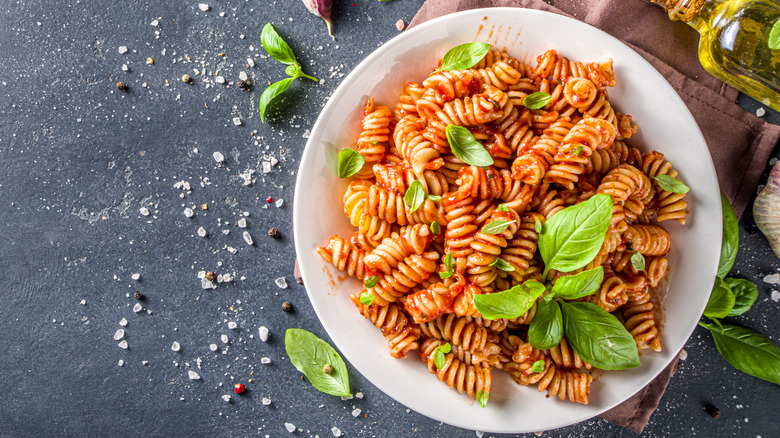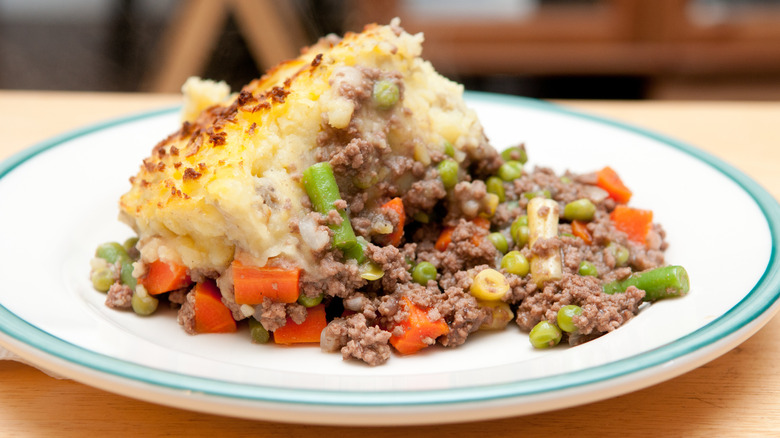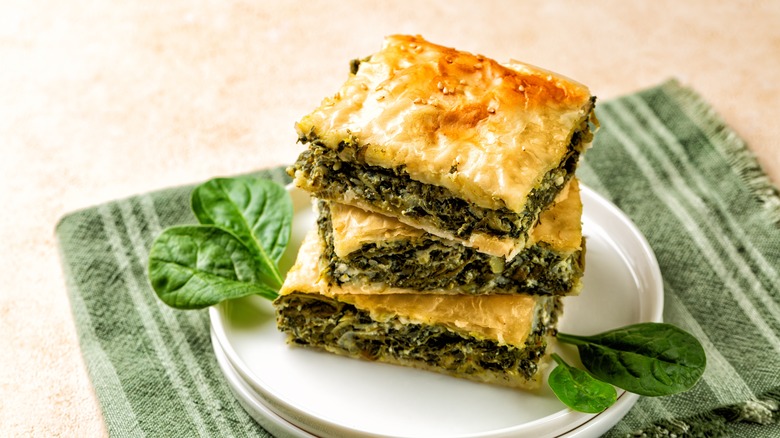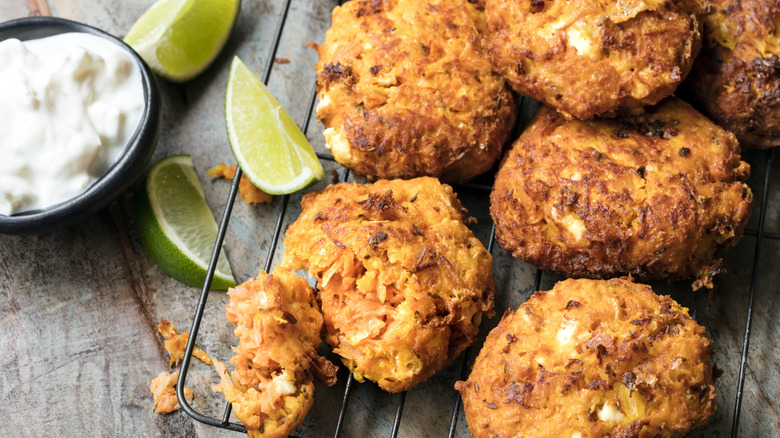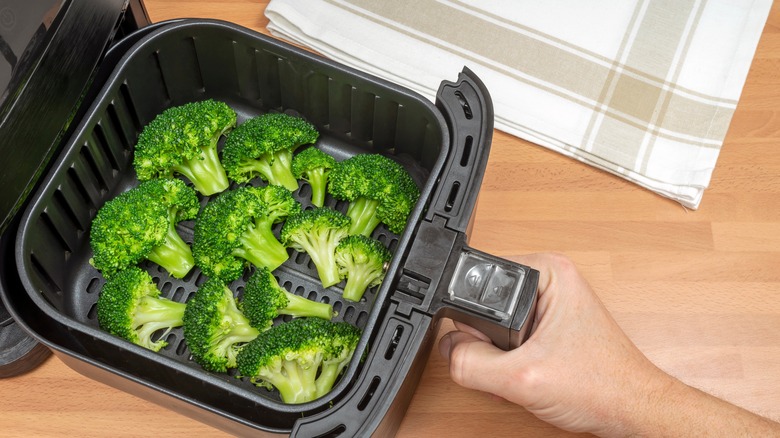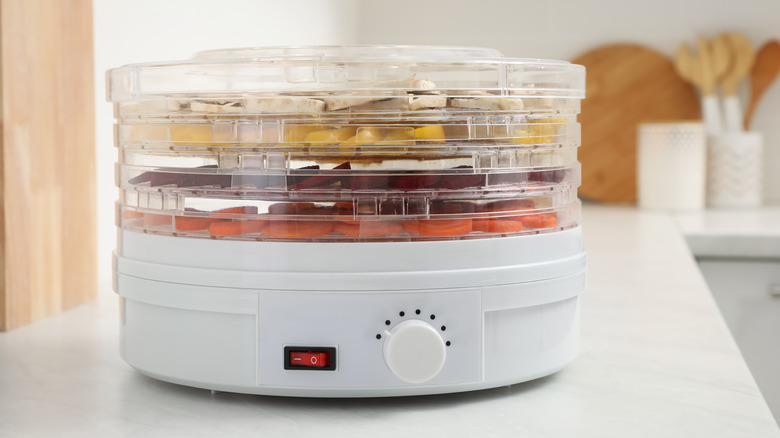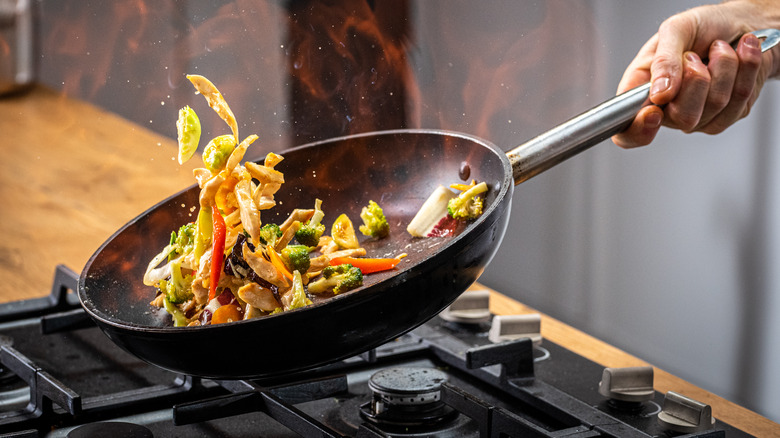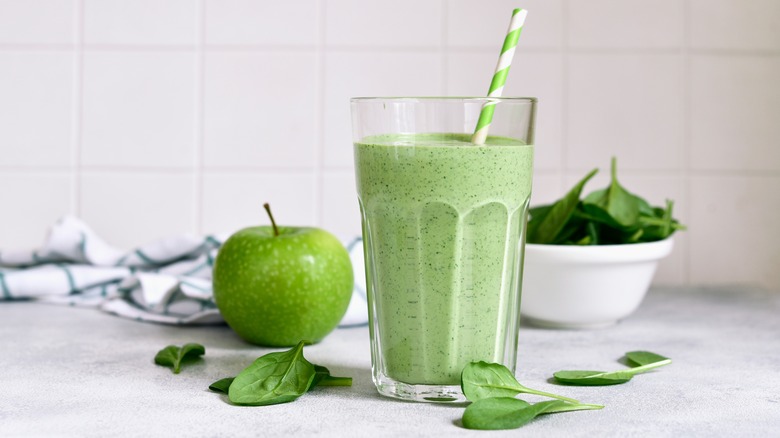How Chefs Use Frozen Vegetables To Take Meals To The Next Level
As a professional chef, nothing inspires me more in the kitchen than freshly picked, perfectly ripe vegetables, straight from the garden. Their color, smell, and taste cannot be beat. That said, their availability is seasonal, and their quality can vary depending upon where you live, making alternatives for producing healthy and delicious meals crucial. This is where frozen vegetables come into play. Though there are plenty of skeptics who don't believe frozen veggies can be as healthy or flavorful as fresh ones, others swear by them, revering them for their affordability, shelf life, and well-documented nutritional value.
Indeed, in a study published by the Journal of Agricultural and Food Chemistry, the vitamin content of eight fruits and vegetables were compared between their fresh and frozen states. The result was that there were no notable differences, and, in certain instances, some nutrients were higher among the frozen vegetables, reinforcing the value of incorporating this produce into your culinary routine.
The key to consuming the healthiest frozen vegetables is to obtain ones that are minimally processed and do not contain any additives. Once you have purchased your high-quality frozen vegetables, you will need some practical tips and tricks on how to use them to take meals to the next level. That's where my experience and expertise come in. I'm here to guide you through the best ways to prepare frozen vegetables for maximum texture and flavor so that you can begin enjoying them, too.
Purée them into a soup
Soups or stews are the place I use frozen vegetables most frequently; they save valuable time and effort because they come pre-processed and chopped. This is particularly useful if I plan to make a big batch of soup to feed a large family or divide into individual portions that I can freeze for later meals. That said, there are some things to keep in mind when using frozen vegetables in soup.
First, you should never thaw frozen vegetables before you add them to your soup or stew, as they can become waterlogged and squishy, giving them a less than stellar texture. Additionally, you will want to add them to the soup toward the end of cooking so that they do not overcook and dissolve into the soup.
Lastly, if you are still not in love with the texture of frozen vegetables in soup, consider puréeing the soup with an immersion blender. I prefer rich, velvety, creamy soups over chunky ones. They feel more sophisticated and are very satiating, and the flavors of all the ingredients meld into one perfect bite.
Roast them in the oven
Few side dishes are as satisfying as perfectly roasted vegetables. As they spend time in the oven, the natural sugars in the vegetables begin to caramelize, creating a savory, nutty, umami-rich flavor and a tender, yet still al dente, texture that pairs beautifully with any meat or fish. While you can use frozen vegetables for this purpose, they take a bit more finesse to achieve the appropriate texture, as they can easily steam, rather than roast, becoming a soggy mess.
First, it is crucial that you preheat your baking sheet in a relatively hot oven, around 450 degrees Fahrenheit, so that the vegetables can begin cooking immediately as opposed to gradually, which would encourage thawing rather than the commencement of the Maillard reaction. Again, do not thaw the frozen vegetables before roasting them. You will want to use vegetables that are slightly larger, and uniform in size, so that they roast evenly.
Before placing the vegetables in the oven, be sure to oil and season them liberally with your favorite spices to infuse them with flavor. It is also important to ensure you place the vegetables on the baking sheet evenly, in a single layer so that they do not overlap, which would further encourage steaming. Finally, do not forget to stir your vegetables halfway through the roasting process to ensure they cook uniformly.
Jazz up your fried rice
Among my favorite weeknight meals that make good use of leftover takeout rice and meat is a quick and easy fried rice recipe. Fried rice is the perfect opportunity to make use of frozen vegetables like carrots, onions, peas, peppers, corn, and more. They require no advance preparation or chopping, and you can add whatever combination of vegetables you enjoy to the mix.
Since fried rice comes together rather rapidly at a higher heat, it is important not to add the frozen vegetables at the beginning of the cooking process. I recommend tossing them in at the same time you add the cooked rice. This enables them to reheat without cooking for too long, which would cause them to become mealy rather than remain slightly toothsome.
The key to amping up your fried rice game is supplementing the recipe with unexpected, quirky ingredients. Consider throwing in some miso or gochujang for funky flavor, tossing in some crunchy macadamia nuts for texture, or topping the whole lot off with a poached egg for a luscious, cheese-like richness that is sure to knock your socks off.
Fuse them into a frittata
Another of my favorite dumping grounds for leftovers, and frozen vegetables, is turning them into a frittata. Eggs are like master culinary prestidigitators that are capable of binding seemingly incompatible ingredients together into a delectable breakfast, lunch, or dinner. All it takes is a little creativity and a cast iron, carbon, or stainless steel skillet that heats uniformly and is able to withstand the high heat of an oven.
The key to the perfect frittata lies in how you treat the eggs. I always add a hint of heavy cream, roughly ¼ cup per six eggs. The cream encourages the frittata to fluff up and turn golden brown as it bakes. It also gives the eggs a rich flavor and a luxurious texture that helps to encase the remaining ingredients added, particularly watery ones like frozen vegetables. You should also season the eggs sufficiently before adding your remaining ingredients. Fresh or dried herbs, spices like paprika or chili powder, aromatics like garlic, and umami-rich condiments like Worcestershire sauce are all ideal to amplify the flavor of your frittata.
Once the eggs and seasonings have been whisked together, toss in your frozen vegetables and any other ingredients you desire. Mix these well and pour the mixture into your skillet before topping with a good-quality shredded melting cheese and baking the frittata in the oven. Serve your frittata with some lightly dressed mixed greens and crusty bread for a meal to remember.
Enhance your tomato sauce
Additional vegetables are among the many ingredients that can enhance a tomato sauce, transforming it into something more nutritious and complex, both texturally and flavor-wise. Tomatoes alone are quite acidic and can lack heft when it comes to clinging to more robust noodles. Vegetables can bulk up the sauce's volume and tame the inherent acidity of the tomatoes, balancing out the flavor and bringing forward more earthy notes.
Though you can use any kind of vegetable, consider those that are more hefty and naturally sweet, like carrots, sweet potatoes, and red peppers. Do not thaw the vegetables; add them to your sauce after it has mostly reduced so that you do not overcook them. Once you have heated them through, I recommend puréeing the sauce together with an immersion blender until it is thick but not totally smooth. You want some of the chunks to remain so that you retain that toothsome texture that will help the sauce adhere to your pasta. And don't forget to reserve some of that starchy water from cooking the pasta. Adding it to your sauce will help it bind to your pasta even better, giving the whole dish a more velvety mouthfeel.
Create a casserole
While some cooks insist that frozen vegetables are subpar for making a casserole, I somewhat disagree. In principle, the reasoning is that as vegetables freeze, their cellular structure will degrade due to the formation of ice crystals. This can render them soggy when added to a casserole. This may be the case to some extent, but if properly handled, frozen vegetables can be effectively incorporated, particularly into those recipes where you will be using a moisture-wicking starch like pasta, rice, or potatoes.
The key is understanding how to use certain vegetables. When I add spinach, kale, or other leafy greens, I thaw and strain them, eliminating any excess liquid. For other vegetables, thawing may be unnecessary, though a quick spin in the microwave can help draw some of that excess liquid out of them, allowing you to drain them before adding them to your casserole.
Whatever you do, never pre-cook your frozen vegetables. Add them directly to the other ingredients and make sure you top the whole thing with breadcrumbs, cracker crumbs, cheese, chopped nuts, or other ingredients that will crisp up and help neutralize some of that excess liquid. And, always allow your casserole to rest for at least 10 minutes after removing it from the oven so that the ingredients have a chance to set, making it easier to serve the dish.
Wrap them in pastry
I'm a sucker for anything wrapped in pastry. Whether you make your own or purchase one of the many convenient store-bought puff pastry, phyllo dough, or pie crust brands, there are so many great appetizers and entrées you can produce where frozen vegetables can easily be snuck in for color, flavor, and nutritional value.
The key is applying similar rationale as you would for a casserole. Since frozen vegetables can easily render your pastry crust limp and soupy, you will want to minimize the amount of moisture that leaches out of them, while retaining their al dente texture. For this reason, not all frozen vegetables may be suitable for popping into a pastry-encased recipe.
That said, some recipes work brilliantly, such as spanakopita or even a shepherd's pie. Leafy greens should be thawed and strained of excess liquid. Other vegetables that work well as-is, without being thawed, are frozen carrots, peas, corn, and edamame. These can be added right into the filling toward the end of cooking, before cooling it completely and stuffing it into your pastry crust. If you are still concerned about a soggy crust, try sprinkling the bottom of the crust with breadcrumbs before adding the filling, and then topping it with additional crumbs before sealing it. This will help to absorb some of that excess liquid.
Foist them into a fritter
If you have ever wondered what a fritter is, it is basically a vegetable patty that gets pan-fried or baked until crispy and then served with a delectable dipping sauce. Perhaps the most famous fritter you can think of is the potato latke of Hanukkah fame. That said, you can make a fritter from virtually any kind of vegetable, including frozen ones.
This is one time where thawing the vegetables you plan to use is a good idea. You will need to ensure they are as dry as possible to prevent the fritters from falling apart when you cook them. Great options for fritters include frozen shredded potatoes, peppers, corn, and even cauliflower.
Once the veggies are thawed, you will need to season them and add eggs to bind them, as well as a filler to create the glue that keeps the veggies together. Common fillers can be flour, cornmeal, or bread crumbs. Whatever you do, do not add too much filler. It can weigh your fritters down and make them dense. A final trick that can help your fritters stay together when you fry them in oil or bake them in the oven is to refrigerate them for at least an hour or as long as overnight before cooking them. Lastly, make sure you cook them over relatively high heat in oil that has a high smoke point so that they crisp up quickly without burning.
Amplify them in the air fryer
While roasting frozen vegetables is a relatively easy and effective method for cooking them, air-frying them is even better. And, believe it or not, frozen vegetables may actually yield better results in the air fryer than fresh ones. The key is the design of an air fryer. By circulating air around the vegetables, it is applying heat evenly, allowing them to crisp up quickly without the need for preheating a baking pan or constant monitoring.
That said, you will want to take a couple of precautions when air-frying frozen vegetables. Never thaw them before use. You should also consider using uniformly sized vegetables so they cook evenly. Before placing the vegetables into your air fryer, spray the bottom of the basket with cooking spray and then layer the vegetables into it in a single layer. Season accordingly with your favorite herbs and spices and top them with cooking spray.
Every air fryer will cook slightly differently, so you will want to monitor your vegetables until you can get a good sense of how long they will take to achieve that slightly crisp yet al dente texture with your specific unit. When your vegetables are done, consider garnishing them with freshly grated parmesan cheese and a hint of balsamic vinegar for a delightful side dish perfect for a quick weeknight dinner.
Desiccate them in the dehydrator
Dehydrated vegetables are a shelf-stable, quick, easy, and nutritious snack for those on the go or planning a rigorous hike. They are also incredibly easy to make. That said, when dehydrating fresh vegetables, it is generally best to blanch them before you desiccate them. The beauty of using frozen vegetables is that they are already pre-cut and usually pre-blanched, meaning all you have to do is take them straight out of the package and toss them into your dehydrator or your oven.
The key is to make sure you do not thaw your vegetables. Layer them evenly onto your baking sheet or dehydrator rack and pop them into your oven or dehydrator unit. Then let time, and low heat, work their magic. Once the vegetables are fully dehydrated, they will need to be cooled completely before getting transferred to an airtight container for long-term storage.
Alternatively, you can take these dehydrated vegetables and pulverize them in a food processor or coffee grinder. This vegetable powder can be used the way you would add spices to any recipe, to amplify the flavor and sneak some vegetables in without anyone knowing it. It is also a perfect garnish for soups, egg dishes, salads, and more.
Spice them up in a stir-fry
Stir-frying may be the best way to cook up frozen vegetables. Frozen vegetables require high heat to cook fast enough to retain their crisp texture. While you can use a wok, any durable cast iron, stainless, or carbon steel skillet that is well-suited to high-heat cooking will suffice. The key is using an oil that has a high smoke point, like vegetable or peanut oil. Once the oil is added to the pan, get it good and hot before you add your frozen vegetables. Whatever you do, do not overcrowd the pan, as this will cause the veggies to steam rather than crisp up.
To enhance the flavor of stir-fried frozen vegetables, don't skimp on the aromatics, like garlic and fresh ginger. You will also want to toss in some umami-rich condiments, like soy or fish sauce, and something spicy, like gochujang. Lastly, consider adding a hint of acidity in the form of lemon juice or rice wine vinegar to brighten up the final flavor of your stir-fry. Serve your stir-fried frozen vegetables with seared tofu or shrimp over steamed rice. Garnish with toasted sesame seeds and chopped peanuts for a quick and flavorful Asian-inspired meal.
Juice up the nutrition in your smoothie
One benefit of using frozen vegetables is that a majority of them are already blanched before they are frozen, meaning they are ready to eat straight out of the packaging. This is great news for those seeking to add them to a quick salad or salsa, but it is even better news for those wanting to juice up the nutrition in their favorite breakfast smoothie recipe.
Many breakfast smoothies call for vegetables like spinach, kale, or even beets to boost flavor and nutrients. Rather than relying on fresh vegetables, which can require some advanced preparation that most of us don't have the time, or energy, for first thing in the morning, take advantage of those veggies in the freezer to speed things along. As a bonus, because the vegetables are frozen, you can skip the ice cubes. The frozen vegetables will help to thicken your smoothie without watering it down, giving it more intense flavor and making it more filling.
